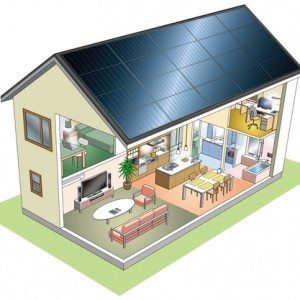 One of the biggest ways to help reduce consumption of fossil fuels and the emission of carbon is for businesses to find a way to scale back their use of electricity. Companies are among the largest consumers of electricity, and electricity accounts for a huge portion of the total oil and natural gas used in the United States, second only to automobiles. Needless to say, most businesses would find it difficult to operate without any sort of electrical power, but there are alternatives to the power grid. Solar power is among the best and most practical, especially for those trying to utilize it on a commercial, rather than city-wide scale.
Converting your business to solar power is not as challenging or expensive as you might assume. In fact, the most costly aspect is simply installing and maintaining the storage system for making use of your collected solar energy. Solar panels themselves are relatively inexpensive and they can last for years. Still, because they can lose some of their efficacy over time, they are typically warranted for about twenty years. Because each panel can only absorb so much energy, it is a good idea to install as many as possible on whatever surface areas you have available. You can even install reflectors around your panels to ensure that as much sunlight as possible is funneled into them.
The panels themselves are only one component of a solar power system that you will need to have installed. The inverters are equally important and often more expensive and troublesome. Inverters are the means by which solar energy is converted into useable electricity, so without them, solar power is of no use. Inverters do not last as long as solar panels and are not typically warranted for more than ten years. Maintaining your inverters is crucial to your business’s ability to make good use of the solar energy you collect.
Once collected, your solar energy will need to be stored in a battery. Batteries range in price from a few hundred to a few thousand dollars, depending on the variety. It is wise to invest in good batteries for your solar power system, especially if you intend to use solar energy as your primary source of electricity. While it is clear that investing in a solar power system is a costly endeavor, you can end up saving large sums of money in the long run. Not only will you reduce your consumption of electricity from the power grid, you may even receive substantial tax write-offs, depending on the laws in your state. Solar energy is the energy source of the future, and it can be as beneficial to your business as it is to the environment.
One of the biggest ways to help reduce consumption of fossil fuels and the emission of carbon is for businesses to find a way to scale back their use of electricity. Companies are among the largest consumers of electricity, and electricity accounts for a huge portion of the total oil and natural gas used in the United States, second only to automobiles. Needless to say, most businesses would find it difficult to operate without any sort of electrical power, but there are alternatives to the power grid. Solar power is among the best and most practical, especially for those trying to utilize it on a commercial, rather than city-wide scale.
Converting your business to solar power is not as challenging or expensive as you might assume. In fact, the most costly aspect is simply installing and maintaining the storage system for making use of your collected solar energy. Solar panels themselves are relatively inexpensive and they can last for years. Still, because they can lose some of their efficacy over time, they are typically warranted for about twenty years. Because each panel can only absorb so much energy, it is a good idea to install as many as possible on whatever surface areas you have available. You can even install reflectors around your panels to ensure that as much sunlight as possible is funneled into them.
The panels themselves are only one component of a solar power system that you will need to have installed. The inverters are equally important and often more expensive and troublesome. Inverters are the means by which solar energy is converted into useable electricity, so without them, solar power is of no use. Inverters do not last as long as solar panels and are not typically warranted for more than ten years. Maintaining your inverters is crucial to your business’s ability to make good use of the solar energy you collect.
Once collected, your solar energy will need to be stored in a battery. Batteries range in price from a few hundred to a few thousand dollars, depending on the variety. It is wise to invest in good batteries for your solar power system, especially if you intend to use solar energy as your primary source of electricity. While it is clear that investing in a solar power system is a costly endeavor, you can end up saving large sums of money in the long run. Not only will you reduce your consumption of electricity from the power grid, you may even receive substantial tax write-offs, depending on the laws in your state. Solar energy is the energy source of the future, and it can be as beneficial to your business as it is to the environment.- Home
- Residential
- Commercial
- Tesla
- Testimonials
- About Us
- Contact Us
Month: December 2015
 One of the biggest ways to help reduce consumption of fossil fuels and the emission of carbon is for businesses to find a way to scale back their use of electricity. Companies are among the largest consumers of electricity, and electricity accounts for a huge portion of the total oil and natural gas used in the United States, second only to automobiles. Needless to say, most businesses would find it difficult to operate without any sort of electrical power, but there are alternatives to the power grid. Solar power is among the best and most practical, especially for those trying to utilize it on a commercial, rather than city-wide scale.
Converting your business to solar power is not as challenging or expensive as you might assume. In fact, the most costly aspect is simply installing and maintaining the storage system for making use of your collected solar energy. Solar panels themselves are relatively inexpensive and they can last for years. Still, because they can lose some of their efficacy over time, they are typically warranted for about twenty years. Because each panel can only absorb so much energy, it is a good idea to install as many as possible on whatever surface areas you have available. You can even install reflectors around your panels to ensure that as much sunlight as possible is funneled into them.
The panels themselves are only one component of a solar power system that you will need to have installed. The inverters are equally important and often more expensive and troublesome. Inverters are the means by which solar energy is converted into useable electricity, so without them, solar power is of no use. Inverters do not last as long as solar panels and are not typically warranted for more than ten years. Maintaining your inverters is crucial to your business’s ability to make good use of the solar energy you collect.
Once collected, your solar energy will need to be stored in a battery. Batteries range in price from a few hundred to a few thousand dollars, depending on the variety. It is wise to invest in good batteries for your solar power system, especially if you intend to use solar energy as your primary source of electricity. While it is clear that investing in a solar power system is a costly endeavor, you can end up saving large sums of money in the long run. Not only will you reduce your consumption of electricity from the power grid, you may even receive substantial tax write-offs, depending on the laws in your state. Solar energy is the energy source of the future, and it can be as beneficial to your business as it is to the environment.
One of the biggest ways to help reduce consumption of fossil fuels and the emission of carbon is for businesses to find a way to scale back their use of electricity. Companies are among the largest consumers of electricity, and electricity accounts for a huge portion of the total oil and natural gas used in the United States, second only to automobiles. Needless to say, most businesses would find it difficult to operate without any sort of electrical power, but there are alternatives to the power grid. Solar power is among the best and most practical, especially for those trying to utilize it on a commercial, rather than city-wide scale.
Converting your business to solar power is not as challenging or expensive as you might assume. In fact, the most costly aspect is simply installing and maintaining the storage system for making use of your collected solar energy. Solar panels themselves are relatively inexpensive and they can last for years. Still, because they can lose some of their efficacy over time, they are typically warranted for about twenty years. Because each panel can only absorb so much energy, it is a good idea to install as many as possible on whatever surface areas you have available. You can even install reflectors around your panels to ensure that as much sunlight as possible is funneled into them.
The panels themselves are only one component of a solar power system that you will need to have installed. The inverters are equally important and often more expensive and troublesome. Inverters are the means by which solar energy is converted into useable electricity, so without them, solar power is of no use. Inverters do not last as long as solar panels and are not typically warranted for more than ten years. Maintaining your inverters is crucial to your business’s ability to make good use of the solar energy you collect.
Once collected, your solar energy will need to be stored in a battery. Batteries range in price from a few hundred to a few thousand dollars, depending on the variety. It is wise to invest in good batteries for your solar power system, especially if you intend to use solar energy as your primary source of electricity. While it is clear that investing in a solar power system is a costly endeavor, you can end up saving large sums of money in the long run. Not only will you reduce your consumption of electricity from the power grid, you may even receive substantial tax write-offs, depending on the laws in your state. Solar energy is the energy source of the future, and it can be as beneficial to your business as it is to the environment.Solar power in 2015 and projections for 2016
Written by goldensolar on . Posted in Solar Power. Leave a Comment
 A new report from GTM Research estimates that 2015 will be a banner year for solar power in the United States. The report is based on a strong third quarter of this year that saw 1,261 megawatts (MW) of solar power installed across the country. The report also predicts that the fourth quarter of 2015 will also show strong growth in solar power installations, and estimates that over 3 gigawatts (GW) of new capacity could be installed. Should reality follow these predictions, it would bring the total installed capacity close to 7.4 GW for the entire year. Last year was also a strong year for solar with 6.2 GW of installed solar capacity, but the estimates for 2015 would eclipse the 2014 installed capacity by 19%.
The GTM Research report also predicts even stronger growth in 2016. The Solar Investment Tax Credit (ITC) was extended by Congress in 2008 and provides certainty for the solar industry. The tax credit is a crucial subsidy that provides a 30 percent tax credit for solar power on distributed generation, or installations on residential and commercial buildings. Unfortunately, the ITC is set to expire at the end of 2016. While this is a source of concern for the solar industry, it also means that 2016 will be a very strong year for solar. According to GTM Research, there is roughly 15.4 GW of new capacity set to come online next year. If this prediction comes to fruition, it will more than double the growth experienced in 2015.
Another encouraging bit of news from the report is that this growth is being driven by an increase in residential solar installations. Residential installments are growing more quickly than non-residential and utility-scale installments. The increase in residential installments is encouraging from both an environmental and economic perspective because it will reduce the need for utility-scale projects that require more land and increase the potential for conflict with other land uses.
This report shows that the growth trend in solar power since 2008 is not slowing down. On average, the cost of solar panels fell 75 percent between 2009 and 2014, and some estimates predict it will drop another 25 percent by 2018. This boom has generated enough electricity to power 4.6 million American homes, a number which is only going to keep rising as more solar power is added.
All of this growth has been accompanied by the continual decrease in the cost of solar energy. For utility-scale solar, the cost of power has dropped almost 60 percent since 2008. The cost of residential and commercial installations has also decreased, one of the major reasons residential and commercial solar has continued to increase year after year. All told, there is a bright outlook for renewable energy in the U.S.
A new report from GTM Research estimates that 2015 will be a banner year for solar power in the United States. The report is based on a strong third quarter of this year that saw 1,261 megawatts (MW) of solar power installed across the country. The report also predicts that the fourth quarter of 2015 will also show strong growth in solar power installations, and estimates that over 3 gigawatts (GW) of new capacity could be installed. Should reality follow these predictions, it would bring the total installed capacity close to 7.4 GW for the entire year. Last year was also a strong year for solar with 6.2 GW of installed solar capacity, but the estimates for 2015 would eclipse the 2014 installed capacity by 19%.
The GTM Research report also predicts even stronger growth in 2016. The Solar Investment Tax Credit (ITC) was extended by Congress in 2008 and provides certainty for the solar industry. The tax credit is a crucial subsidy that provides a 30 percent tax credit for solar power on distributed generation, or installations on residential and commercial buildings. Unfortunately, the ITC is set to expire at the end of 2016. While this is a source of concern for the solar industry, it also means that 2016 will be a very strong year for solar. According to GTM Research, there is roughly 15.4 GW of new capacity set to come online next year. If this prediction comes to fruition, it will more than double the growth experienced in 2015.
Another encouraging bit of news from the report is that this growth is being driven by an increase in residential solar installations. Residential installments are growing more quickly than non-residential and utility-scale installments. The increase in residential installments is encouraging from both an environmental and economic perspective because it will reduce the need for utility-scale projects that require more land and increase the potential for conflict with other land uses.
This report shows that the growth trend in solar power since 2008 is not slowing down. On average, the cost of solar panels fell 75 percent between 2009 and 2014, and some estimates predict it will drop another 25 percent by 2018. This boom has generated enough electricity to power 4.6 million American homes, a number which is only going to keep rising as more solar power is added.
All of this growth has been accompanied by the continual decrease in the cost of solar energy. For utility-scale solar, the cost of power has dropped almost 60 percent since 2008. The cost of residential and commercial installations has also decreased, one of the major reasons residential and commercial solar has continued to increase year after year. All told, there is a bright outlook for renewable energy in the U.S.Solar Power Plants – Different types of utility-scale solar
Written by goldensolar on . Posted in Solar Power. Leave a Comment
 Since 2008, the cost of solar power has consistently fallen every year while the amount of capacity installed grows year-over-year. Much of this growth has been through small-scale solar, photovoltaic (PV) systems on residential and commercial properties. However, this short time period has also seen impressive improvements in utility-scale solar power. Utility-scale solar is a crucial for attaining our carbon dioxide emissions goals, but is less well-known than its rooftop cousin. Here is a brief primer on utility-scale solar and solar power plants.
Utility-scale solar power plants can take the form of several different technologies: concentrating solar power (CSP), PV systems, and concentrating photovoltaic technology (CPV). All of these technologies generate clean energy at much greater scales than typical PV installations, and the electricity is sold to wholesale buyers, not the end-users. This setup is more similar to other public utilities that generate electricity from natural gas or coal than PV systems on residential or commercial properties.
There are a few different CSP technologies in use, which all consist of mirrors that reflect and concentrate sunlight on central pipes filled with a transfer fluid, typically synthetic oil or liquid hydrogen. When the fluid is heated to a certain temperature, it generates steam that turns a turbine that creates electricity. There are three common types of CSP plants: parabolic troughs, compact linear fresnel reflectors (CLFR), and power towers. A parabolic trough consists of concave mirrors that direct reflected sunlight onto a central fluid pipe, which transports the heated transfer fluid. Similarly, CLFR systems also use curved-mirror trough technology, but the reflected energy is focused onto an elevated receiver consisting of tubes transporting flowing water. The power tower approach uses a central receiving system atop a tall tower that captures the reflected energy from computer-controlled flat mirrors that track the sun.
Since 2008, the cost of solar power has consistently fallen every year while the amount of capacity installed grows year-over-year. Much of this growth has been through small-scale solar, photovoltaic (PV) systems on residential and commercial properties. However, this short time period has also seen impressive improvements in utility-scale solar power. Utility-scale solar is a crucial for attaining our carbon dioxide emissions goals, but is less well-known than its rooftop cousin. Here is a brief primer on utility-scale solar and solar power plants.
Utility-scale solar power plants can take the form of several different technologies: concentrating solar power (CSP), PV systems, and concentrating photovoltaic technology (CPV). All of these technologies generate clean energy at much greater scales than typical PV installations, and the electricity is sold to wholesale buyers, not the end-users. This setup is more similar to other public utilities that generate electricity from natural gas or coal than PV systems on residential or commercial properties.
There are a few different CSP technologies in use, which all consist of mirrors that reflect and concentrate sunlight on central pipes filled with a transfer fluid, typically synthetic oil or liquid hydrogen. When the fluid is heated to a certain temperature, it generates steam that turns a turbine that creates electricity. There are three common types of CSP plants: parabolic troughs, compact linear fresnel reflectors (CLFR), and power towers. A parabolic trough consists of concave mirrors that direct reflected sunlight onto a central fluid pipe, which transports the heated transfer fluid. Similarly, CLFR systems also use curved-mirror trough technology, but the reflected energy is focused onto an elevated receiver consisting of tubes transporting flowing water. The power tower approach uses a central receiving system atop a tall tower that captures the reflected energy from computer-controlled flat mirrors that track the sun.
Photovoltaic solar plants
Photovoltaic solar plants operate similarly to residential PV systems, but are constructed at a much larger scale. PV panels are constructed from semiconducting materials, often silicon, that absorb solar energy and separate the electrons from sunlight and redirect them into an electrical current. These PV plants often require large tracts of land that are not always available, but the cost of PV technology continues to fall, making large PV plants a more economical solution than its peers. The last type of utility-scale solar is not yet implemented at the scale of the other two, but is considered a viable alternative to CSP plants. Concentrating photovoltaic technology also uses lenses or mirrors to concentrate sunlight, but differs from CSP because the sunlight is redirected onto high-efficiency solar cells. These cells are similar to PV cells, but are more concentrated. This decreases the required cell surface area and increases the efficiency of the panels. Unfortunately, they are also more expensive at this stage. All of these utility-scale solar technologies represent exciting alternatives to fossil fuels. With each passing year the technology improves, the price drops, and more clean energy enters the transmission grid.Environmental Benefits of Using Solar Power
Written by goldensolar on . Posted in Green Living, Solar Power. Leave a Comment
 The recent Paris climate conference has garnered significant media attention and further highlighted the importance of addressing global climate change. The issue of energy is at the heart of these talks as nations try to determine how to transition away from fossil fuel to renewable sources to combat climate change. One of the main draws of solar power is that it can help countries drastically reduce their carbon footprint; however, there are also other environmental benefits to solar power.
The recent Paris climate conference has garnered significant media attention and further highlighted the importance of addressing global climate change. The issue of energy is at the heart of these talks as nations try to determine how to transition away from fossil fuel to renewable sources to combat climate change. One of the main draws of solar power is that it can help countries drastically reduce their carbon footprint; however, there are also other environmental benefits to solar power.
Reduction of air pollution
The most well-known air pollutant from fossil fuels is carbon dioxide (CO2), one of the primary greenhouse gases contributing to global climate change; yet, it is far from the only one. Coal combustion releases nitrogen oxides, sulfur dioxide, particulate matter, mercury, and many other hazardous substances. Nitrogen oxide alone contributes greatly to the acidification of lakes and streams, which is detrimental to water resources, flora, and fauna. Furthermore, these compounds strongly contribute to smog, the brown cloud that hovers over so many cities. Burning natural gas is slightly cleaner, but still contributes large amounts of volatile organic compounds (VOCs) and methane, which also contribute to smog and are linked to a variety of respiratory ailments. Quite simply, solar power eliminates all of these pollutants because it does not require the burning of fossil fuels.Cleaner water
The recent fracking boom in the U.S. has brought attention to the threat it poses to water supplies. The large volumes of water used in the fracking process can stress surface and ground water supplies; the Ohio Environmental Council estimates that an average well may use 5.6 million gallons per frack. As a comparison, that amount of water could supply an average family for 51 years. The growth of fracking also greatly increases the risk of groundwater contamination. Spills, faulty well construction, and fracking discharge can all contribute to water contamination. The acquisition and transport of fossil fuels has also resulted in many high profile oil spills over the past couple decades, including the Exxon Valdez in Prince William Sound, Alaska, and the more recent Deepwater Horizon oil spill in the Gulf of Mexico. There have also been countless spills around the world into freshwater sources. Additionally, because solar power only requires the sun and some photovoltaic panels, many of the activities that threaten water supplies are avoided.More efficient land use
Many ecosystems around the world face the consistent degradation of natural habitats from human use. In some cases, solar power also contributes to this, but it also has the potential to greatly reduce the environmental footprint of energy generation by utilizing the existent infrastructure in cities around the world. A transition to localized energy generation, a real possibility with solar power, would reduce the need for expansive transmission networks and sprawling power plants that degrade the natural environment. All things considered, there are many environmental benefits to solar power, and a shift to solar could improve our air, water, and ecosystems.









